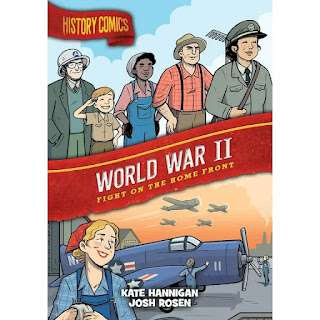Josh Rosen follows up on illustrating a piece of graphic history with every other one, this time focusing on the house front of World Battle II in the US. Working with creator Kate Hannigan, World Battle II: Strive towards On The Dwelling Entrance (a section of the Historical previous Comics sequence from First 2nd) is a reasonably frequent heart-grade guide. Hannigan does her most attention-grabbing to bag at just some of the racial and gender inequality in the US and the diagram the requires of the war temporarily modified things, however the guide peaceful dipped true into a microscopic bit of that “V for Victory” spirit that used to be so prominent in media and custom for the time being in the US.
Rosen’s persona make is the superstar of the existing, from the four formative years who are the narrators of the account to comic caricatures of world leaders to extra naturalistic drawings of well-known figures from history. The attention-grabbing order about the guide is how it well-known aspects the means whereby the US went about enticing in total war, nationalizing a vary of its industries to depart into manufacturing items for its war effort. The propaganda machine used to be a substantial section of this (and Hannigan if truth be told did employ that time duration once in the guide), making an strive to persuade the populace that doing things love rationing sources, occurring extended scrap hunts for steel and rubber, and even organising “victory gardens” in every corner of the city to again bolster meals on the house front had been worth the sacrifice.
Propaganda or no longer, and despite an extended anti-war motion (with diverse motives, including a talented-German Bund motion), it used to be peaceful astonishing to see a nation based on rugged individualism aquire true into a collective ethical as broadly as the US did for the time being. No doubt, this used to be all over the FDR administration, where the crumple of the US financial system allowed for favorite socialist applications that had a profound and big sure affect. This collective action towards a decidedly malignant foe in Nazi Germany saved the populace at house engaged, as every person used to be made to feel they had been doing their section. What’s attention-grabbing is how this engaged marginalized groups. That incorporated women americans, who had restricted employment and tutorial opportunities. It incorporated Dim other folks, who compelled their means into jobs and then better-paying jobs because our bodies had been wanted. It did no longer encompass Japanese-American citizens, as Hannigan does build huge demonstrate of the internment camps.
Hannigan’s strategy of telling the account by some neighborhood formative years easiest works because Rosen used to be so ethical at the employ of them to directly stammer on the yarn itself. Their snarkiness towards the “victory” propaganda used to be comic, even as the formative years peaceful had been inspiring in some systems. Then every other time, they also reflected the difficulties of rationing, especially when things love sugar and dairy rationing intended that ice cream stopped being a section of day-to-day lifestyles. Hannigan notes that surplus of items following the war, with an excellent deal of sourced anecdotes and statistics (love gallons of ice cream eaten!). All suggested, that is a stable primer brought to lifestyles by Rosen’s expressive and a large selection of characters. The coloration scheme used to be barely mighty the First 2nd house sort, that approach it wasn’t especially attention-grabbing nor intrusive; it did the job and thankfully did no longer interfere with Rosen’s line art.



